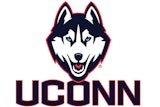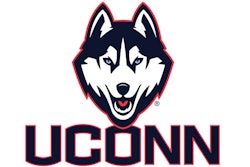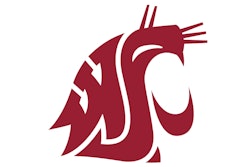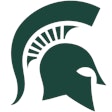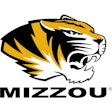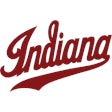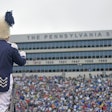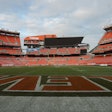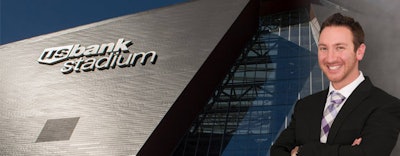
Billy Langenstein got his start in the event-management game as a 15-year-old water boy at music venues in Philadelphia. He later spent five seasons with the Washington Nationals, ascending to director of event operations. Today, at age 28, he's SMG's director of events services for U.S. Bank Stadium, the newly minted home of the Minnesota Vikings. The stadium will host more than 400 events a year — from weddings to concerts to college baseball games — all under a clear plastic roof and Langenstein's watch. On Vikings gamedays, he's ultimately responsible for everything from transportation and emergency response to the actions of thousands of security and guest-services personnel. AB senior editor Paul Steinbach caught up with Langenstein the morning after the Vikings had played their second home preseason game in four days.
How much sleep have you gotten over the past two weeks?
Not much. It's a lot of moving parts and long days — anywhere from 16 to 20 hours a day.
Is a Vikings home game a different animal than, say, your Aug. 20 Metallica concert?
Absolutely. Two different types of demographics, two different types of people. It could just be buyers who might come to the stadium once in their lifetime just to see that band, and they really don't learn the stadium in that one visit, versus a football game, where we're catering to a different market — our season-ticket members. These are high-paying buyers who are committed to the team and who want to be here every Sunday. It's also a different animal because there's broadcast involved. It's nationally televised, and the NFL has rules and regulations that we abide by.
Which is more likely to keep you up at night?
I think both have unique challenges. No matter what event we're preparing for, the safety and security of the stadium, our staff and our guests is of the utmost importance. Preparing for a concert, you're dealing with a promoter, and there are a lot of last-minute changes. A football game is very routine. We're following a timeline. The ball is going to be kicked off at 12:07. Broadcast comes in five hours prior. It's very regimented and it becomes like a habit.
What about the stadium design process could make the job of someone in your position easier?
Everyone has ideas of what the functionality of a stadium should be, but not necessarily what it's going to be. I think having a person who understands events and has that type of experience on board helps to ask the right questions — "Well, if you put an elevator here, what's its purpose and how's it going to work with crowd movement and where's it going to go and what signs should be there and do we need stanchioning and do we need staff?" That helps create a stadium where you don't have these ah-ha moments — "Why was a wall placed right there?" — once you start operating.
How did you manage the security planning for a stadium already under construction?
When I came on board, I looked at all the stadium plans. What did we have in the Metrodome when it was there? When the team was at TCF Bank Stadium, there really were no relative plans for security. You have the NFL best practices, but we had to go in and build every single plan, process and system protocol from scratch. All of my colleagues from around the stadium industry have helped, and we looked at the key essentials — from staffing to access to incident management to command and control. And we looked at all these different protocols — from something as simple as how to handle riding a golf cart to how to handle an ejection, and everything in between. I created the relationships among the city and took their thoughts and suggestions and comments and started to mold all these different protocols and policies of what will deliver a successful event and help every department be successful. And I created task lists. I can't tell you how many lists I have for what it took to sort of keep organized and push forward.
Was there any one area that drew most of your focus?
You start to go through the infrastructure plan and ask, "Okay, where can we improve based on things we've learned from other teams in other stadiums, and what are some of the trends that are happening in our world — both fortunate and unfortunate — that we need to prepare for? We have an opportunity to do it now building a new stadium." So one of the big things I focused on was our command centers — our stadium operations center and our joint operations center. Our command and control is so important, because that really is the epicenter that runs our stadium. One of the big things was going back in and really redesigning what was already built into the stadium and elevating it to a level that we wanted.
What changes were you able to make to the command center?
The plan was already there. There were four walls up when I got here, but I redesigned the technology that's in there. I want additional television monitors, additional computers, and I want an additional countertop, and this is how I'm going to run it. That infrastructure — from data and power to the televisions and computers and the furniture — I redesigned.
When did you feel confident that you could safely open the stadium to the public?
July was when we said, "Yep, we're feeling good." We got into the building. That was one of the big challenges we had. We couldn't get our staff in the building to train, because the stadium was still under construction. So we had to teach offsite. And now we're in a different phase. We planned, we educated, we've been executing. Our plans have been tested for a month now. Now we continue to evaluate. We go back and we evaluate and debrief and look at how all our plans were tested. What did we forget? What did we learn? What do we have to elevate or do a little bit differently? And then we continue to adjust. So now we're adjusting them and we continue to get better and learn each event as a team.
What's one example of an adjustment you've made?
One of the things we learned was that our wayfinding signage is really important. Not that everyone reads the signage, but it was really important to add a support system to our staff. So I'd say one of the big things that we learned was what signs do we put in what locations to help us grow — to help educate our staff, but also educate our guests, so that when a staff member gives someone a direction, there's a sign maybe 30 feet down the way. It reinforces that trust that the staff member told the person the right way to go.
Sleep deprivation notwithstanding, how's your job satisfaction?
The team here at the stadium, from the Minnesota Vikings to SMG to the Minnesota Sports Facility Authority, has been an unbelievably great team to work with. Yes, I work with the stadium, but my job is much more than football on Sundays. I'm so grateful and happy and fortunate that every day I come to work it's filled with variety and challenge and teamwork. I get the opportunity to make people smile and create memories that will last a lifetime. It's so much fun, and that's the gratification of what we do in sports and entertainment, and that's why it's great to be here.
This article originally appeared in the October 2016 issue of Athletic Business with the title "Behind the wheel (and launch) of the Vikings’ ship"














